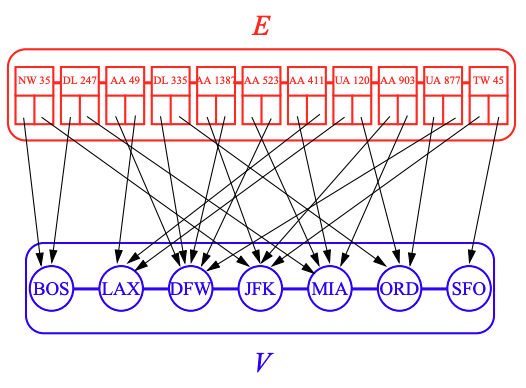Store two unsorted lists
- A vertex sequence with a list of vertices
- An edge sequence with a list of vertex pairs
Where is the # of vertices, is the # of edges

Use a doubly linked list as the container for and for optimal time complexity
Using an array is easier but things like
removeEdgewill become due to increased deletion time complexity
Time complexities
Where is the # of vertices, is the # of edges
| Operation | Complexity | Notes |
|---|---|---|
| Space | Two lists | |
insertVertex(x) | Add to V sequence | |
insertEdge(u,v,x) | Add to E sequence | |
removeVertex(v) | Need to traverse edges to remove incident edges | |
removeEdge(e) | Remove from sequence - given doubly-LL | |
degree(v) | Traverse all edges to count | |
incidentEdges(v) | Traverse all edges to return incident one | |
getEdge(u,v) | Traverse all edges to return pointer to matching pair | |
endVerticesOf(e) | Edge pointer given - return the relevant vertex pointers | |
opposite(v,e) | Edge pointer given - return other vertex | |
vertices() | Traverse V | |
edges() | Traverse E | |
numVertices() | Dependent on a counter variable | |
numEdges() | Dependent on a counter variable |
- Can be implemented as a pair of Doubly-linked list where the nodes store two pointers to the connected vertices
- Array can also be used - the array can store tuples of vertex pointers. Worse time complexity
Directed graph information
See this link